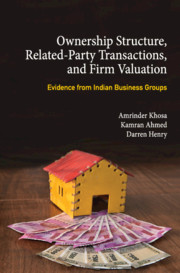 Ownership Structure, Related Party Transactions, and Firm Valuation
Ownership Structure, Related Party Transactions, and Firm Valuation Book contents
- Frontmatter
- Contents
- List of Tables
- 1 Introduction
- 2 The Evolution of Business Groups, Institutional Framework in India, and Related-Party Transactions
- 3 Theory and Literature Review
- 4 Hypotheses Development
- 5 Research Methods
- 6 Descriptive Statistics
- 7 Empirical Results
- 8 Additional Tests
- 9 Implications of the Study and Conclusion
- Appendix 1 List of Sample Firms
- Appendix 2 List of Business Groups
- References
- Index
6 - Descriptive Statistics
Published online by Cambridge University Press: 26 April 2019
- Frontmatter
- Contents
- List of Tables
- 1 Introduction
- 2 The Evolution of Business Groups, Institutional Framework in India, and Related-Party Transactions
- 3 Theory and Literature Review
- 4 Hypotheses Development
- 5 Research Methods
- 6 Descriptive Statistics
- 7 Empirical Results
- 8 Additional Tests
- 9 Implications of the Study and Conclusion
- Appendix 1 List of Sample Firms
- Appendix 2 List of Business Groups
- References
- Index
Summary
Introduction
This chapter presents descriptive statistics and other preliminary statistical tests to provide insights into the ownership structure and the RPTs disclosure of sample firms. First, the descriptive statistics of the entire sample comprising 1,530 firm-year observations are presented. This is followed by division of the sample into two categories: (a) firms which have disclosed RPTs, and (b) firms which have not disclosed any RPTs. Further analysis is then conducted by dividing RPTs based on the association with the related party. RPTs with subsidiary and holding companies are separated from RPTs with other group member firms. These analytical steps provide an important overview of firm characteristics and RPT disclosure. Finally, the Pearson correlation matrix is presented to identify any potential multicollinearity problems.
Descriptive statistics of the full-sample
This section provides descriptive statistics for all research variables, including firm-specific characteristics of the sample. Independent variables consist of direct and indirect ownership of controlling shareholders, minority ownership, and the magnitude of RPTs, whereas the dependent variable is the MVE. Table 6.1 provides descriptive statistics for the full sample of 1,530 firm-year observations.
The dependent variable, MVE, has a mean value of INR 211 with a maximum value of INR 8,799 and a minimum of INR 0.42. The average book value of equity is INR 127, with a maximum value of INR 5,051 and a minimum of INR -497. Average earnings per share amount to INR 20 and median earnings are INR 7, with a maximum of INR 1,436 and a minimum of INR -1,297. Average direct ownership of controlling families (DIROWN) amounts to 15 per cent only, with a median ownership level of 7 per cent. Indirect ownership of controlling families (INDOWN) averages 34 per cent of the total ownership, with a maximum value of 88 per cent and a minimum ownership level of zero. The minimum value of zero represents no indirect ownership, which suggests that such firms are controlled through direct ownership only. The results suggest that the proportion of indirect ownership through cross-holding is significantly higher than direct ownership, as the average holding of indirect ownership is more than double the proportion of direct ownership. This explains the prominence of cross-holdings in the context of the study. The average shareholding of minority shareholders with minimal holding (MINORITY1) is 16 per cent, whereas the average shareholding of minority shareholders with significant holding (MINORITY2) is 5 per cent.
- Type
- Chapter
- Information
- Ownership Structure, Related Party Transactions, and Firm ValuationEvidence from Indian Business Groups, pp. 97 - 111Publisher: Cambridge University PressPrint publication year: 2019
